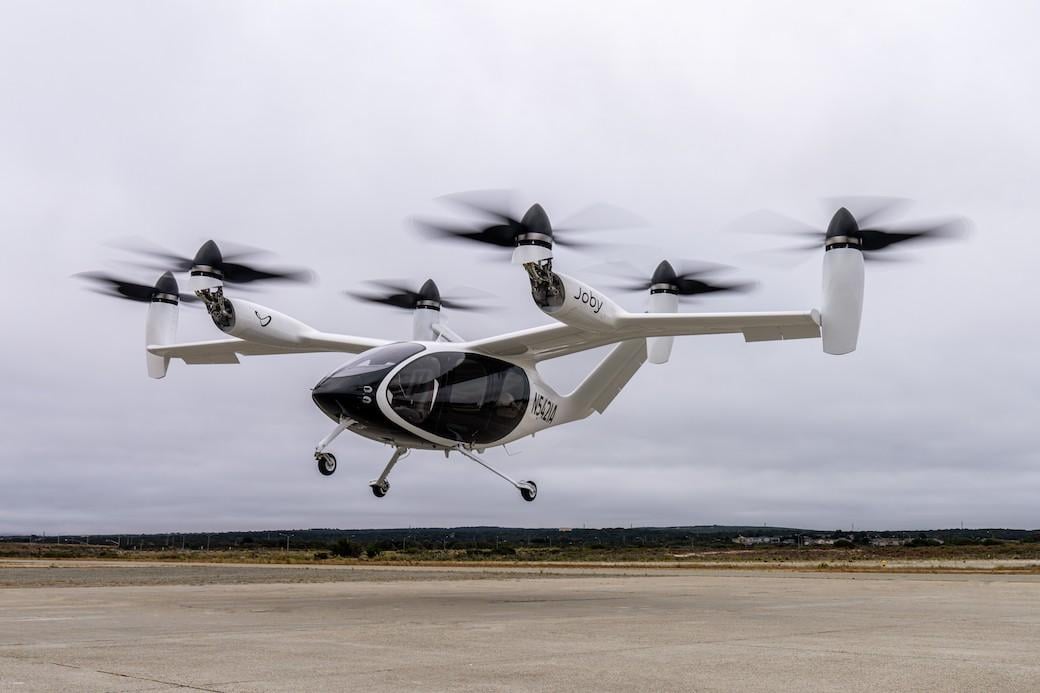
Joby plans to operate its own air taxi service in addition to being an OEM.
Many investors bought into electric air taxi companies in 2021 hoping to find the next Tesla, but instead they may be stuck with the next Uber.
U.S. startups Archer and Joby Aviation appear on track to launch services by 2025, and German startup Volocopter by mid-2024 in Europe. But even assuming those initial services launch and are on time as planned—which is far from guaranteed—investors in the electric-vertical-takeoff-and-landing (eVTOL) space should remain clearheaded about what could be a prolonged road to profitability.
That is especially true in the case of companies like Archer, Joby and Volocopter, all of which not only plan to manufacture their vehicles but to operate them as well. As the case of Uber demonstrates, turning a profit in the ride-hailing business is extremely difficult. It took the company around 15 years to finally do so in the 2023 second quarter. Apply that model to air taxi services and investors can be expected to end up subsidizing operating losses for years.
To be sure, there will be other opportunities for early revenues from governments or defense customers, especially in the cases of Archer and Joby, which have partnered with the U.S. Air Force. And unlike Joby, Archer plans to sell its aircraft to customers in addition to operating them, part of its dual market strategy.
Germany’s Lilium, on the other hand, appears to have largely abandoned its planned air taxi network for a more traditional OEM business model. Its focus has shifted from urban to regional air mobility, a move that can be viewed as a quiet admission of the challenges inherent in the vertically integrated air taxi model.
The advanced air mobility (AAM) industry has largely convened around the $1 billion figure as the likely amount needed to type certify an eVTOL aircraft. But to turn a profit as a vertically integrated OEM/operator, it might require up to $3-4 billion, according to industry watcher Sergio Cecutta, founder and president of SMG Consulting.
There are two likely business strategies that companies such as Joby, Archer and Volocopter are likely to pursue in their early years to get around this challenge, Cecutta said. One would be to operate as a premium service from the get-go, pricing the trips to align with operating costs but setting aside the vision of mass adoption for the time being. “But this means that customers are unlikely to see anything close to the promised $3 per passenger-mile anytime soon,” Cecutta warns.
The second option would be to follow in Uber’s footsteps and price the product at a loss with a focus on expanding ridership to establish a dominant market share. That approach could prove costly and drawn out. In Uber’s case, investors subsidized around $30 billion in operating losses until the company finally realized a profit this past quarter and only after fare increases of roughly 50%, a move that could open the door to more competition from lower-priced entrants.
“If these companies want to sell the tickets for what it costs to operate the service, then it will have to be a very premium offering and they should make peace with that,” Cecutta says. “You’re going to be talking something like $8 per passenger-mile [of operating costs] at entry-into-service. Maybe over time you could make it more accessible, but if you want to do that from day one, then it means the price needs to be subsidized.”
Archer’s recent move to hire Uber Elevate co-founder Nikhil Goel as new chief commercial officer may be an indication of the path it plans to take. Speaking recently to Aviation Week, Goel said the company’s focus “is not so much profitability as quickly as possible, but instead the goal is to expand ridership. If it takes more investment to do that, that’s an option.”
When asked how Archer could turn a profit operating its air taxi services, Goel said each iteration of the vehicle will come with better batteries and lower operating costs. Eventually, he said the pilot can be removed for remote operations, which will help achieve greater scale and further reduce operating costs.
“The beautiful thing about this technology is every part is set up with a really aggressive cost curve that will decrease precipitously with scale,” Goel said. “The load factors will only increase. The vehicle will get more affordable with scaled manufacturing, and the cost to operate the vehicle will come down as autonomous tech gets better. So, the best thing we can do to drive that cost curve down is to get adoption as quickly as possible and continue to expand ridership.”
To his credit, Goel could be correct that taking a narrow focus on profitability in the early stages of urban air mobility (UAM) need not be the goal if costs will come down with scale. But even if he’s right, investors in the eVTOL space should still prepare for the likely possibility of an extended period of subsidized operating losses.





